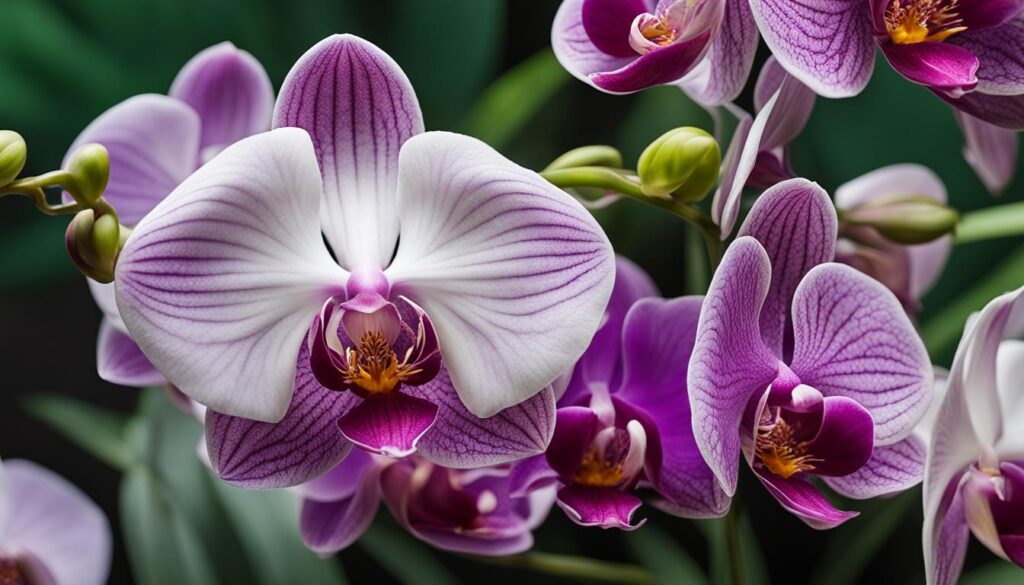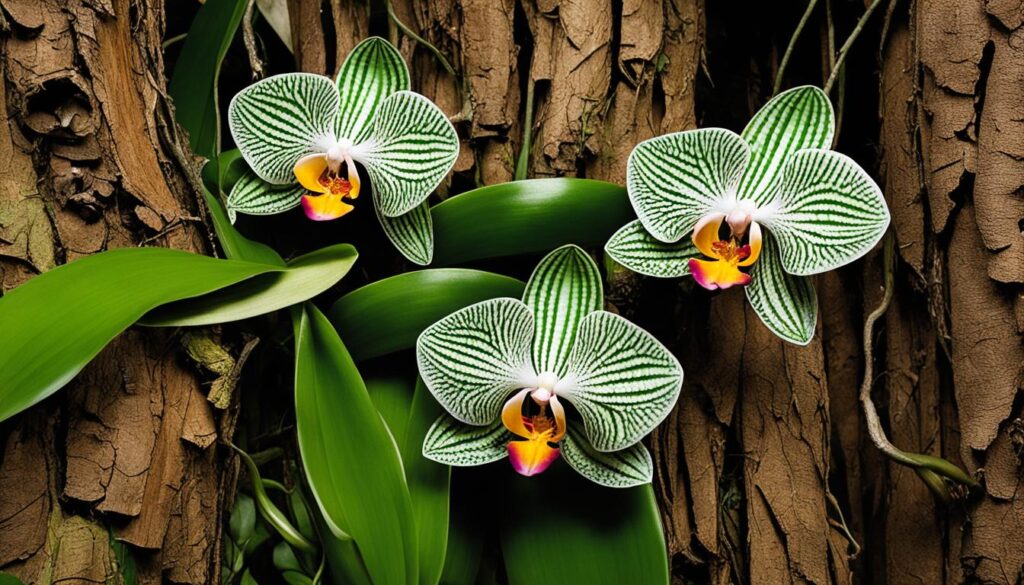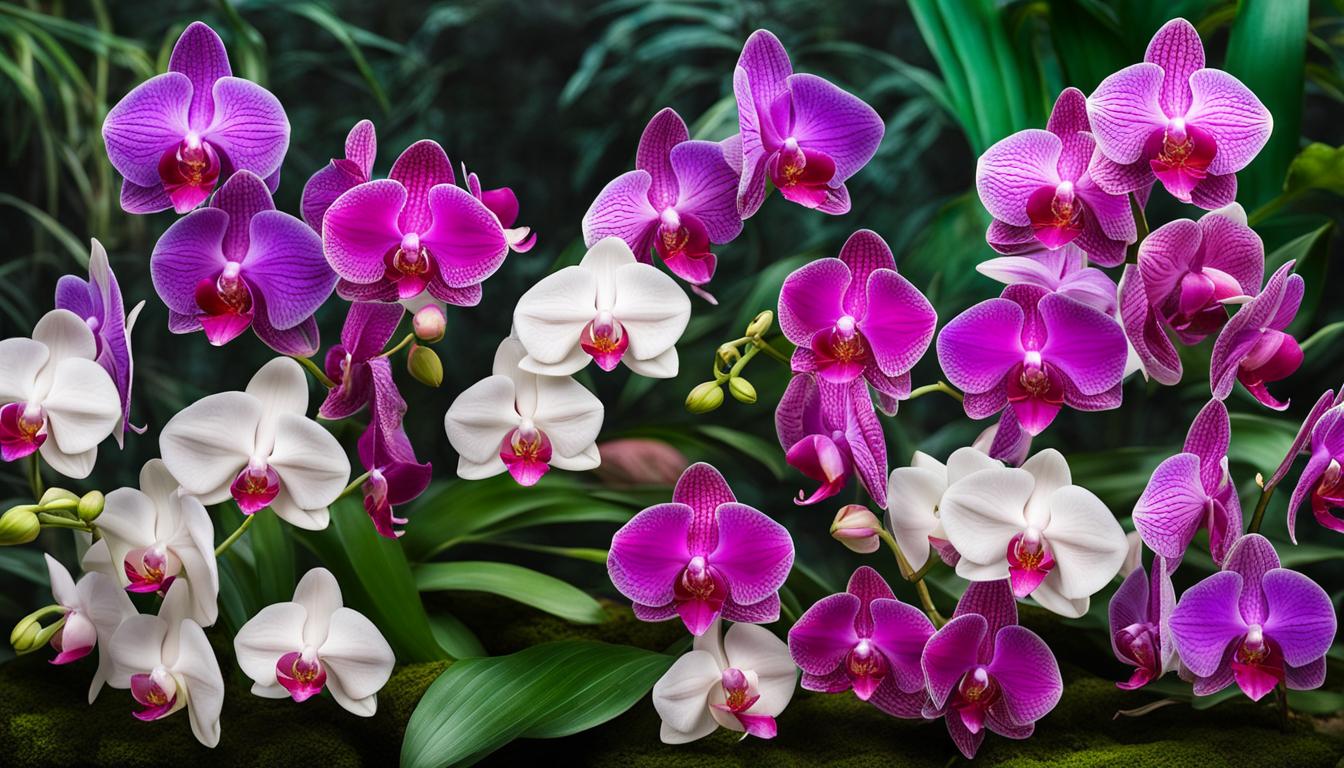Phalaenopsis orchids, often known as “moth orchids,” boast a wide array of varieties, featuring colors that span from the purest whites and pastels to vibrant yellows, pinks, and even patterns with spots or stripes.
Quick Facts
| Characteristic | Detail |
|---|---|
| Countries of Origin | Southeast Asia, Philippines, and Australia |
| Colors | Wide range including white, pink, purple, yellow, and multicolored patterns |
| Size | Small to large, with leaf span varying widely among species and hybrids |
| Difficulty To Grow | Easy, making them popular among beginners |
| Bloom Season | Can bloom any time of year, with proper care; flowers can last several months |
| Light Requirements | Low to medium, indirect light; no direct sunlight |
| Watering Needs | Consistent moisture needed, but allow to dry slightly between waterings |
| Temperature Range | Warm; prefers temperatures between 65-80°F (18-29°C) during the day |
| Potting Medium | Well-draining, such as sphagnum moss or bark mix, allowing roots to breathe |
| Propagation Methods | Typically through keiki (baby plant) growth or division |
| Common Pests and Diseases | Watch for mealybugs, aphids, and root rot; overall, quite hardy |
| Fragrance | Some species and hybrids are fragrant, with a range of scents |
| Lifespan/Longevity | With proper care, can live for many years; capable of multiple bloom cycles annually |
| Conservation Status | Most commercial varieties are not endangered, but wild species vary in conservation status |
| Unique Features | Known for their long-lasting flowers and ability to re-bloom from the same spike under optimal care |
In gardens of many colors and lovely scents, the phalaenopsis orchids stand as wonders. They are special flowers that never stop amazing.
These orchids can live in many places. And they come in a million beautiful faces. Their colors sing songs of color and joy.
I have learned to love the best of these orchids. They are strong flowers that make any plant spot beautiful.
Do you want to see the most lovely phalaenopsis blooms? Or just enjoy the amazing beauty of orchids? Learn the many types. Understand their special Varieties. This is a great experience.
Key Takeaways
- The vibrant colorful phalaenopsis orchids cater to a wide array of aesthetic preferences.
- Best phalaenopsis orchids combine beauty with robustness, making them ideal for both beginners and seasoned collectors.
- The types of phalaenopsis orchids available allow for a satisfying discovery of forms, sizes, and patterns.
- Familiarity with various Phalaenopsis Orchid Varieties enhances the knowledge and appreciation for this captivating genus.
- Exploring and choosing the right orchids can significantly elevate both personal and commercial spaces.
- My personal journey to discover these blossoms invites others to seek the unique characteristics of each variety.
A Journey Through the History of Phalaenopsis Orchids
My fascination with phalaenopsis orchid species began when I delved into their rich history. Their journey starts with the earliest botanical descriptions by naturalists such as Rumphius in the 18th century.
It was the visionary work of Dr. Karl Ludwig Blume in 1825 that marked the genesis of their cultivation. Phalaenopsis orchids, initially mistaken for other genera like Epidendrum and Cymbidium, eventually gained recognition as a separate and unique genus.
Meticulous research and exploration led to the identification and classification of a multitude of Phalaenopsis species, with, according to the 2010 World Checklist of Monocotyledons, an official tally standing at 61 species, subspecies, and natural hybrids.
The geographical distribution of these enchanting flowers spans across South and Southeast Asia, an expanse that has seen these orchids thrive in varied habitats.
The success and proliferation of phalaenopsis orchids can be observed through their horticultural significance and ever-increasing popularity among gardeners and botanists worldwide.
Through my work, I’ve learned of the genus’s adaptability, which has made it ideal for hybridization, creating countless varieties that appeal to orchid lovers across the globe.
| Century | Discovery / Event | Significant Contributor |
|---|---|---|
| 18th | First recorded botanical account | Rumphius |
| 19th | Introduction to cultivation | Dr. Karl Ludwig Blume |
| 21st | World Checklist of Monocotyledons confirms 61 species and hybrids | Botanical community |
Representing a fragment of my ongoing journey with these orchids, I continue to marvel at their evolutionary path—from misty forests to cherished domesticated specimens.
The Enchanting World of Phalaenopsis Orchid Varieties
Stepping into the enchanting world of Phalaenopsis orchids, one is met with a variety that spans the well-known to the delightfully obscure. Among popular phalaenopsis orchids, Phalaenopsis amabilis, or the “moth orchid,” enchantingly flutters as an enduring favorite.
Phalaenopsis Amabilis and Its Popularity in Cultivation
Prized for its captivating beauty, Phalaenopsis amabilis marks a pivotal point in orchid cultivation. With broad, graceful leaves and stunning flowers enduring in beauty, it’s no wonder this species has transitioned from a cherished rarity to a mainstream treasure.
In my journey through botanical cultivation, the resilience and adaptability of this orchid have stood as a testament to its time-honored appeal in both private collections and commercial productions.

Rare and Unique Phalaenopsis Species
Yet, beyond the familiar, there exists a realm of rare phalaenopsis orchids and unique phalaenopsis orchids waiting to be uncovered. As a connoisseur of orchids, I’ve been drawn to these lesser-known variants, finding a richness that extends the diversity of the genus.
Horticulturists worldwide revel in the discovery of new species, contributing extraordinary colors and patterns that continuously reshape our understanding and appreciation for these floral wonders.
Spotlight on the Prolific Phalaenopsis Equestris
And then there’s Phalaenopsis equestris, a name that resonates with abundance and vibrancy. Its exceptional floriferous nature and the multitude of blooms it presents through hybrid phalaenopsis orchids make it an undeniable pillar in the Phalaenopsis family.
My dedicated explorations have often centered on this species, recognized for its significant impact in breeding and the delightful range of hybrids that emerge from its lineage.
As we delve deeper into this world, we discover that each Phalaenopsis carries a unique story, a chronicle of beauty, survival, and evolution that continues to fascinate and inspire those of us enamored with these botanical jewels.
Understanding the Botanical Aspects of Phalaenopsis Orchids
The enchanting allure of Phalaenopsis orchids is not just skin deep; their botanical description reveals an intricate and fascinating structure. As an avid observer and cultivator, I’ve come to appreciate the remarkable monopodial growth of these epiphytic species.
Unlike other plants that sprawl or climb, Phalaenopsis orchids grow vertically, launching a single stem skyward, which bears a suite of succulent leaves. This growth pattern is particularly suited to their natural habitats, where chasing light amongst dense canopies is a game of survival.
- Epiphytic Lifestyle: Thriving high on tree trunks, Phalaenopsis orchids are quintessential epiphytes. Their roots, exposed to the air, grasp onto bark, harvesting moisture and nutrients from the environment.
- Leaf Arrangement: Each stem is a showcase for lush, leathery leaves that form a symmetrical crown, a design that is both visually pleasing and functionally efficient in catching dew and rain.
- Floral Display: The flowers bloom in an array of forms, from the solitary splendors to the intricate cascades of branching inflorescences. This diversity in flowering strategy ensures a broad appeal, capturing the hearts of orchid lovers everywhere.
In my nursery, I have observed another exquisite characteristic that sets these plants apart, their inherent polyploidy. This genetic endowment bestows them with additional sets of chromosomes, leading to greater genetic variation and an unmatched potential for cultivating new ornamental varieties.
Thanks to polyploidy, Phalaenopsis flowers are typically more robust, with enhanced color intensity and a greater resilience against environmental stressors.
Phalaenopsis orchids embody a delicate balance between grace and scientific marvel. Their singular structures not only contribute to their singular beauty but also underscore their botanical uniqueness within the Sarcantheae subtribe.
Dissecting their anatomy, from root to petal tip, I’ve become deeply acquainted with their distinctiveness. Their botanical quirks are not mere footnotes in textbooks but rather vital chapters in the narrative of each bloom that graces my greenhouse.

My dedication to these striking flora is more than a passion—it’s a voyage into the heart of botanical complexity. In my years nurturing them, I have forged a connection with the very essence of these stunning epiphytes, a testament to the awe-inspiring diversity of the natural world.
Phalaenopsis Orchids: A Tapestry of Colors
My fascination with the best phalaenopsis orchids has always been drawn to their exceptional spectrum of shades; from the understated beauty of white phalaenopsis to the searing vibrancy of the more colorful varieties.
The elegance of these blooms encapsulates not just a visual feast but also reflects a storied past steeped in floricultural artistry.

The Classic Elegance of White Phalaenopsis Orchids
White Phalaenopsis orchids, known for their timeless beauty, hold a special place in the hearts of orchid lovers. Representing purity and grace, they have become staple elements in elegant bouquets and as exquisite ornamental plants in countless homes.
Acknowledged for their serenity and lasting impression, these orchids carry a sense of sophistication unmatched by other floral contenders.
Colorful Phalaenopsis Orchids That Brighten Any Space
Colorful phalaenopsis orchids are the vibrant counterpoints that brighten any room with their assortment of hues. They not only enhance the visual appeal of a space with their vivid colors but also evoke a sense of joy and liveliness. I’ve always found their ability to enliven an environment simply by their presence to be truly remarkable.
Decoding the Shades: From Pastels to Vibrant Hues
In my experience, exploring the spectrum of phalaenopsis orchids has been akin to deciphering a rainbow of flora. With pastel phalaenopsis orchids, one can indulge in a more subtle beauty that whispers elegance, while the vibrant hues shout a resounding ode to nature’s painterly touch.
Floricultura’s commitment to nurturing a diverse range of these enchanting species has notably contributed to the global spread and appreciation of these colorful gems.
| Orchid Variety | Color Range | Description |
|---|---|---|
| White Phalaenopsis | Pure and Crisp White | Symphony of simplicity and elegance perfect for weddings and classical decor. |
| Pastel Phalaenopsis | Soft Pinks, Lilacs, Yellows | Ideal for a gentle pop of color, adding a springtime softness to any space. |
| Vibrant Phalaenopsis | Bright Pinks, Reds, Oranges | These bold colors make a statement and are sure to captivate and energize viewers. |
Cultivating Your Own Phalaenopsis Orchids
As an avid gardener, the allure of Phalaenopsis orchids is undeniable. Their graceful blooms and vibrant colors provide a touch of exotic elegance to any indoor space. Cultivating these orchids is a fascinating process, one that requires attention to their particular needs.
Achieving that lush, flourishing state where orchids bloom consistently involves more than just admiration, it’s about providing the right care for Phalaenopsis orchids.
To guide you through the essentials for a thriving orchid, here’s an outline to ensure your Phalaenopsis orchids not only survive but also thrive and flower beautifully.
- Light: Phalaenopsis orchids prefer bright, indirect sunlight. East-facing windows are ideal, or a shaded south-facing window.
- Watering: Keep the potting media slightly moist but never soggy. Watering once a week is a good baseline, but adjust according to humidity levels.
- Humidity: These tropical plants love humidity. Aim for 60-70%—utilizing humidifiers or trays filled with water and pebbles can help maintain these levels.
- Temperature: Phalaenopsis orchids enjoy warmth. Daytime temperatures between 70-80°F (21-27°C) and night temperatures no lower than 60°F (15°C) are ideal.
- Fertilization: Use a balanced orchid fertilizer at half strength, ideally every other week to nourish your plants.
- Repotting: Orchids typically need repotting every 1-2 years. Ensure you’re using the right type of bark or moss specific for orchids to prevent root rot.
Remember, patience and persistence are key. It might take time to find the perfect balance that your particular orchid requires.
But once established, the reward of vibrant Phalaenopsis blossoms becomes a testament to your care and commitment.

If you’re beginning your journey with these mesmerizing plants or looking to refine your technique, keep these pointers in mind:
While Phalaenopsis orchids are indeed more forgiving than many of their orchid family counterparts, they still command respect and care tailored to their nature. It is this dedication to understanding and meeting their needs that transforms the practice of cultivating orchids from mere gardening into a form of art.
In the end, the process of nurturing Phalaenopsis orchids can be incredibly rewarding. By creating the ideal growth environment and observing the changes and development of your orchids, you gain not only beautiful blooms but also an enriching experience of connection with the natural world.
Conclusion
As we’ve journeyed through the enchanting world of Phalaenopsis orchids, one cannot help but be captivated by the rich history and dazzling array of varieties this genus boasts.
My own passion for these flowers has been greatly fueled by their fascinating evolution from horticultural novelties to well-established favorites within the world of floriculture.
To discover the multitude of Phalaenopsis orchids varieties and their alluring colors is to appreciate nature’s profound ability to infuse our lives with beauty.
The resilience and adaptability of these orchids are just as noteworthy as their visual splendor. From the pristine whites to the most colorful Phalaenopsis orchids, each variety presents a unique story that is inextricably linked with the art and science of botany and cultivation.
Their rise to prominence as both cut-flower mainstays and as beginner-friendly plants serves as a poignant reminder of the interplay between human innovation and nature’s inherent gifts.
In essence, my exploration into the realm of Phalaenopsis orchids has been a testament to their significance. These floral gems have not only withstood the test of time but have flourished, inspiring both novice and seasoned growers to immerse themselves in their care.
As I reflect on the diverse aspects that make up the Phalaenopsis genus, I extend an invitation to others to delve into this mesmerizing floral tapestry, to discover and be delighted by the vibrance and variety these remarkable orchids contribute to our world.
FAQ
What are some popular types of Phalaenopsis orchids?
Some of the most popular Phalaenopsis orchids include Phalaenopsis amabilis, known for its beauty and ease of care, and the prolific Phalaenopsis equestris, valued for its abundant blooms and significance in hybridization. Other well-loved types include Phalaenopsis schilleriana and Phalaenopsis aphrodite.
Can you provide a brief history of Phalaenopsis orchids?
Phalaenopsis orchids have a rich history dating back to the 18th century, with their formal cultivation beginning in 1825. They were originally classified under different genera such as Epidendrum and Cymbidium before receiving their own genus. Over time, 61 species, subspecies, and natural hybrids have been officially recorded, and they’ve become highly valued for their beauty and diversity.
Why is Phalaenopsis amabilis particularly significant in orchid cultivation?
Phalaenopsis amabilis, often referred to as the “moth orchid,” is significant in cultivation due to its desirable characteristics, such as large, long-lasting flowers and broad, flat leaves. It was one of the first phalaenopsis orchids to be widely cultivated and has played a pivotal role in the development of hybrid orchids.
Are there any rare or unique Phalaenopsis orchid species?
Yes, there are several rare and unique species within the Phalaenopsis genus. Species such as Phalaenopsis lindenii and Phalaenopsis deliciosa are considered rare and possess distinct characteristics that make them highly prized among collectors and useful in hybridization to introduce new traits into common varieties.
How does the monopodial growth of Phalaenopsis orchids affect their care?
The monopodial growth habit of Phalaenopsis orchids means they grow upward from a single stem, adding leaves to the crown and blooming from the sides. This growth pattern requires support for the flower spikes, and understanding it is crucial for proper pruning, repotting, and overall care to ensure the orchids thrive.
What types of environments do Phalaenopsis orchids thrive in?
Phalaenopsis orchids are epiphytic and thrive in environments with high humidity, good air circulation, and indirect, bright light. They prefer warm climates similar to their natural habitats in South and Southeast Asia and benefit from consistent moisture and a well-draining growing medium.
How do I maintain the vibrant colors of my colorful Phalaenopsis orchids?
To maintain the vibrant colors of colorful Phalaenopsis orchids, provide them with adequate light without exposing them to direct sunlight, which can be too harsh. Also, consistent fertilization during the growing season can help improve color vibrancy. Avoid extreme temperatures, which can cause color fading or damage.
What makes white Phalaenopsis orchids a classic choice for home decor?
White Phalaenopsis orchids exude timeless elegance and purity, making them a classic choice for home decor. Their simplicity and sophistication are versatile for any setting, and they easily complement different interior design styles. Moreover, their long-lasting flowers and ease of care add to their appeal as household plants.
How does Floricultura contribute to the variety of Phalaenopsis orchids?
Floricultura is a key player in the horticultural industry, specializing in the cultivation and supply of young orchid plants, including a wide variety of Phalaenopsis orchids. They focus on selecting, breeding, and propagating exceptional Phalaenopsis varieties, introducing new colors and patterns to the market and thus contributing significantly to the variety available to consumers.
What are some tips for successfully cultivating my own Phalaenopsis orchids?
To cultivate Phalaenopsis orchids successfully, ensure they have a warm environment, sufficient indirect light, and high humidity. Water them when the potting medium is nearly dry, and fertilize regularly during the growing season. Avoid overwatering and ensure good air circulation to prevent diseases. Regular monitoring and appropriate care will encourage consistent blooms.


Leave a Reply